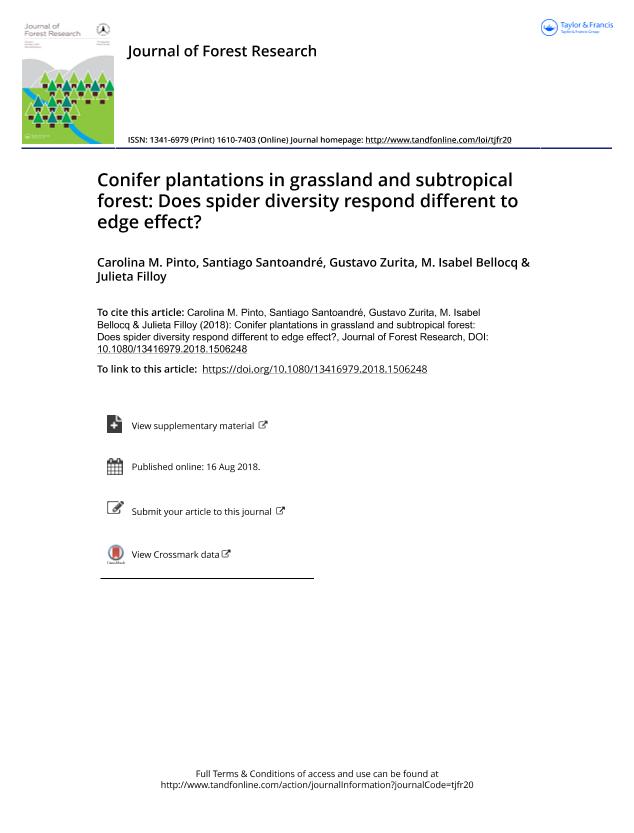Mostrar el registro sencillo del ítem
dc.contributor.author
Pinto, Carolina Melisa

dc.contributor.author
Santoandre, Santiago

dc.contributor.author
Zurita, Gustavo Andres

dc.contributor.author
Bellocq, Maria Isabel

dc.contributor.author
Filloy, Julieta

dc.date.available
2020-02-03T20:52:00Z
dc.date.issued
2018-09
dc.identifier.citation
Pinto, Carolina Melisa; Santoandre, Santiago; Zurita, Gustavo Andres; Bellocq, Maria Isabel; Filloy, Julieta; Conifer plantations in grassland and subtropical forest: Does spider diversity respond different to edge effect?; Springer Tokyo; Journal Of Forest Research; 23; 5; 9-2018; 253-259
dc.identifier.issn
1341-6979
dc.identifier.uri
http://hdl.handle.net/11336/96626
dc.description.abstract
Two adjacent habitats separated by an abrupt transition often cause strong alterations in environmental conditions resulting in what is called the edge effect. The structural similarity between the adjacent habitats determines how abrupt the transition is. We explored the response of spider communities to the edge effect in mature pine plantations and compared for the first time those responses in contrasting biomes (subtropical forest and grassland) in southern South America. We expect that the higher the contrast between the natural habitat and the conifer plantation, the higher will be the magnitude and the lower the extent of the response of species richness and abundance to edge effect. We sampled spiders using pitfall traps located from the edge to the plantation interior, and environmental variables were measured in pine plantations (Pinus taeda) adjacent to native grassland and subtropical forest. Results revealed that wandering spiders were sensitive to edge effect in both subtropical forest and grassland, primarily reflected by a decline in the abundance toward plantation interiors. However, the magnitude and the extent of spider abundance response to the edge effect were similar between pine plantations developing in forest and grasslands biomes. Microclimatic conditions and vegetation cover partially explained species abundance from the edge to plantation interior. Our findings suggest that conifer plantations would promote spider richness if a wide range of microhabitats were provided and support the use of spider abundance to assess edge effect in forested landscapes.
dc.format
application/pdf
dc.language.iso
eng
dc.publisher
Springer Tokyo

dc.rights
info:eu-repo/semantics/openAccess
dc.rights.uri
https://creativecommons.org/licenses/by-nc-sa/2.5/ar/
dc.subject
ABUNDANCE
dc.subject
FORESTRY
dc.subject
LAND USE
dc.subject
SPECIES RICHNESS
dc.subject
WANDERING SPIDERS
dc.subject.classification
Ecología

dc.subject.classification
Ciencias Biológicas

dc.subject.classification
CIENCIAS NATURALES Y EXACTAS

dc.title
Conifer plantations in grassland and subtropical forest: Does spider diversity respond different to edge effect?
dc.type
info:eu-repo/semantics/article
dc.type
info:ar-repo/semantics/artículo
dc.type
info:eu-repo/semantics/publishedVersion
dc.date.updated
2019-10-09T20:42:58Z
dc.journal.volume
23
dc.journal.number
5
dc.journal.pagination
253-259
dc.journal.pais
Japón

dc.journal.ciudad
Tokyo
dc.description.fil
Fil: Pinto, Carolina Melisa. Consejo Nacional de Investigaciones Científicas y Técnicas. Oficina de Coordinación Administrativa Ciudad Universitaria. Instituto de Ecología, Genética y Evolución de Buenos Aires. Universidad de Buenos Aires. Facultad de Ciencias Exactas y Naturales. Instituto de Ecología, Genética y Evolución de Buenos Aires; Argentina
dc.description.fil
Fil: Santoandre, Santiago. Consejo Nacional de Investigaciones Científicas y Técnicas. Oficina de Coordinación Administrativa Ciudad Universitaria. Instituto de Ecología, Genética y Evolución de Buenos Aires. Universidad de Buenos Aires. Facultad de Ciencias Exactas y Naturales. Instituto de Ecología, Genética y Evolución de Buenos Aires; Argentina
dc.description.fil
Fil: Zurita, Gustavo Andres. Consejo Nacional de Investigaciones Científicas y Técnicas. Centro Científico Tecnológico Conicet - Nordeste. Instituto de Biología Subtropical. Universidad Nacional de Misiones. Instituto de Biología Subtropical; Argentina
dc.description.fil
Fil: Bellocq, Maria Isabel. Consejo Nacional de Investigaciones Científicas y Técnicas. Oficina de Coordinación Administrativa Ciudad Universitaria. Instituto de Ecología, Genética y Evolución de Buenos Aires. Universidad de Buenos Aires. Facultad de Ciencias Exactas y Naturales. Instituto de Ecología, Genética y Evolución de Buenos Aires; Argentina
dc.description.fil
Fil: Filloy, Julieta. Consejo Nacional de Investigaciones Científicas y Técnicas. Oficina de Coordinación Administrativa Ciudad Universitaria. Instituto de Ecología, Genética y Evolución de Buenos Aires. Universidad de Buenos Aires. Facultad de Ciencias Exactas y Naturales. Instituto de Ecología, Genética y Evolución de Buenos Aires; Argentina
dc.journal.title
Journal Of Forest Research

dc.relation.alternativeid
info:eu-repo/semantics/altIdentifier/url/https://www.tandfonline.com/doi/full/10.1080/13416979.2018.1506248
dc.relation.alternativeid
info:eu-repo/semantics/altIdentifier/doi/http://dx.doi.org/10.1080/13416979.2018.1506248
Archivos asociados
